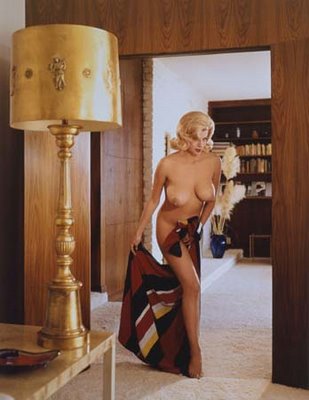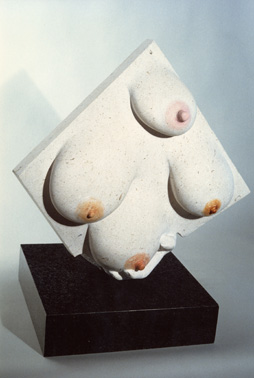
Russ Meyer, Lorna on green cushion (1964/2002)
C-print (custom color print Fuji crystal dyecoupler), 20 x 16 inches unframed, edition of 20

Russ Meyer, Lorna and gold lamp, 1964/2002
C-print (custom color print Fuji crystal dyecoupler), 14 x 11 inches unframed
"I like women who are epically built, bounteous, super-abundant; who have humongous, conical, sleek, blue-veined giganzos accessorized by protuberant nipples surrounded by aureoles double the circumference of a silver dollar! Bosom Maximus!" These are the criteria Russ Meyer, now 80, and the closest thing America has produced to Rabelais, says he will use to cast an upcoming movie to be called either The Bra of God or Beyond the Valley of Pulp a Go-Go. [..] Variously dubbed "King Leer," "Hollywood primitive," "trash master" and "dirty old man," this self-proclaimed "King of the Nudies" and "glandscape artist" not only defined the sexploitation genre, he practically invented it.
[..]
In 1959 he made The Immoral Mr. Teas, the story of a man who can see through women's clothing. Shot in four days for $24,000, the film grossed more than a million. Since then, Meyer has directed 23 films -- most of them moneymakers -- and become a legend. His 1965 classic, Faster, Pussycat! Kill! Kill!, the story of three go-go dancers who set off on a killing spree, was deemed "the worst film ever made" by the San Francisco Chronicle. John Waters, on the other hand, asserts it's "beyond a doubt, the best movie ever made. . . . possibly better than any film that will ever be made in the future." Best or worst, Meyer, who lives in Hollywood Hills, is currently having his first New York gallery show. The exhibition, a display of 21 black-and-white and color photographs -- some of them stills from movie productions, most studio shots -- is a batty mix of cheesiness, camp, chasteness ("I don't consider what I do pornography. I call it 'tittie boo' ") and over-the-top (and I do mean top) voluptuousness. "I start to get interested at about a D cup," Meyer has said. "Anything smaller than that is just too small for me. It doesn't matter to me if the boobs are real or fake as long as they're huge."
(from the Village Voice article "Bosom Maximus - "Russ Meyer" Feigen Contemporary" by Jerry Saltz, June 3rd, 2002)




































